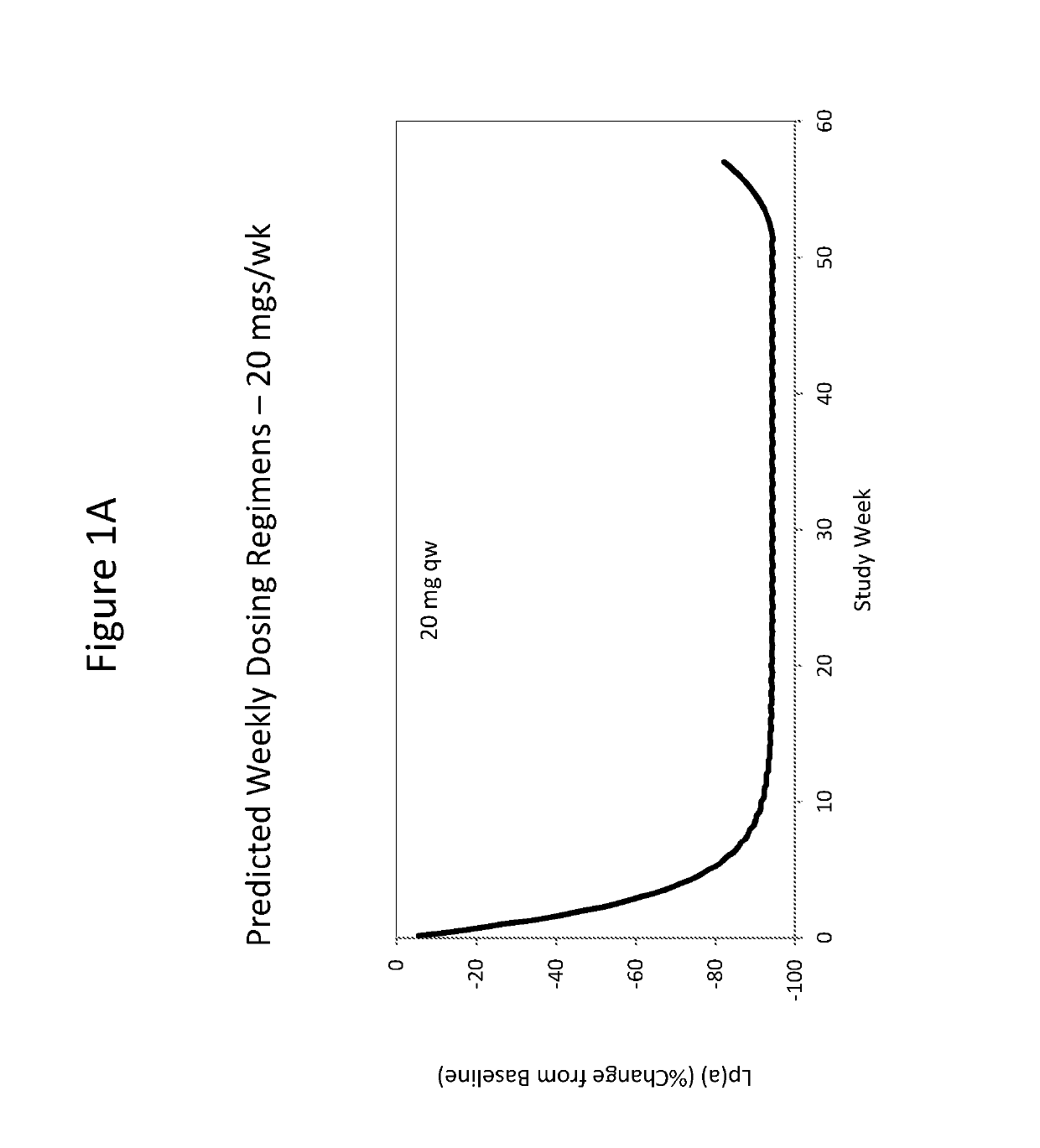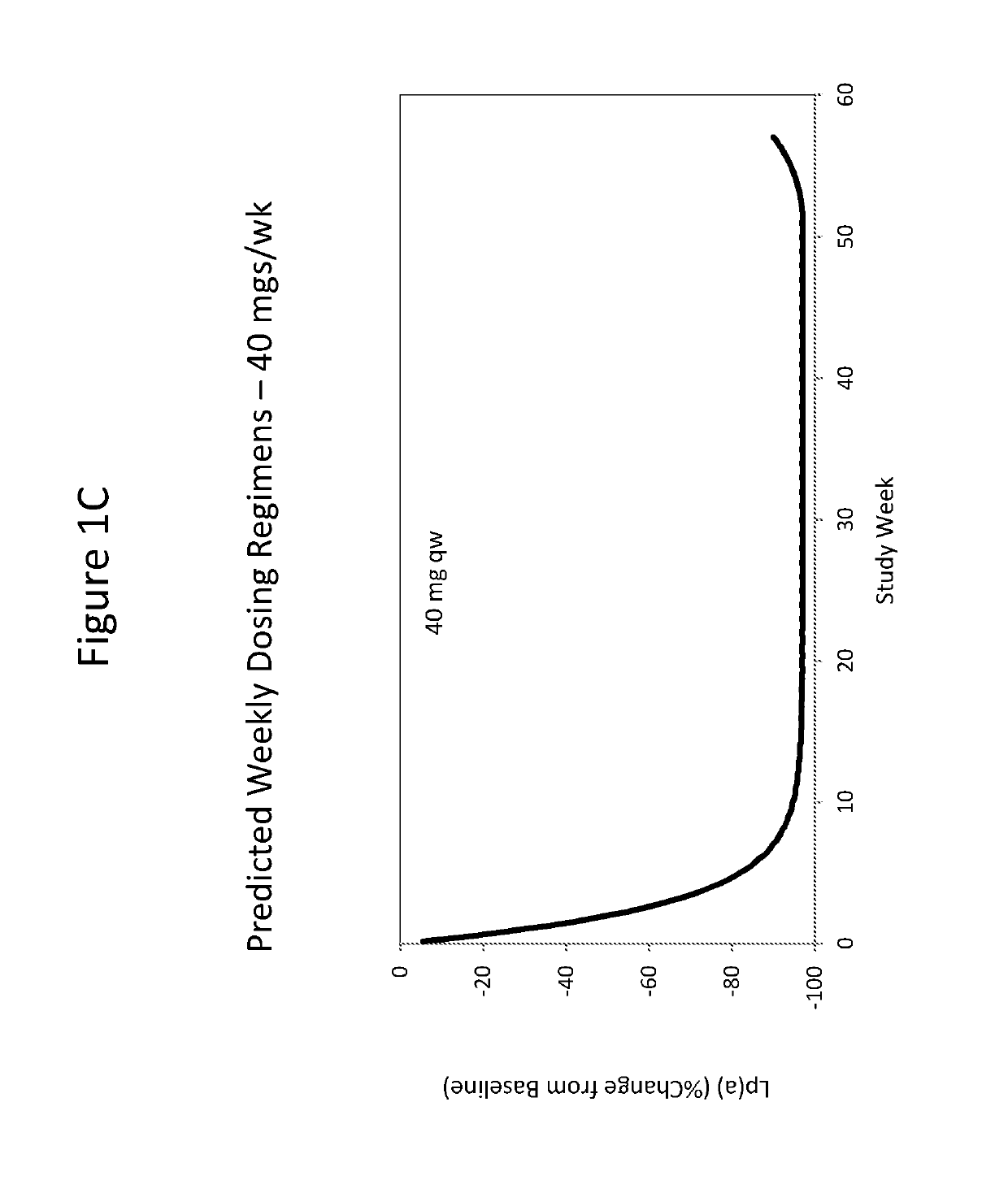Modulating apolipoprotein (a) expression
a technology of apolipoprotein and expression, applied in the field of modulating apolipoprotein (a) expression, can solve the problems of limited therapeutic strategies for treating cardiovascular disease by directly targeting apo(a) levels, interfere with the function of microrna, etc., and achieve excellent reduction of apo, efficacious dosing, and effect of lowering apo(a) mrna and plasma lp
- Summary
- Abstract
- Description
- Claims
- Application Information
AI Technical Summary
Benefits of technology
Problems solved by technology
Method used
Image
Examples
example 1
[0371]As described herein, a double-blinded, placebo-controlled, dose-escalation Phase 1 study was performed on healthy volunteers with elevated Lp(a) to assess safety, tolerability, pharmacokinetics (PK) and pharmacodynamics (PD) after administration of single and multiple doses of ISIS 681257. ISIS 681257 was previously disclosed in WO 2014 / 179625 and is also described hereinabove. ISIS 681257 has been shown to be potent in inhibiting Lp(a) and tolerable when administered to non-human subjects. This subsequent study revealed unexpectedly improved properties of ISIS 681257 when administered to human subjects.
Screening
[0372]Up to 28 days prior to treatment, subjects were screened for eligibility to participate in the study. Admission criteria for the study include the following:[0373]1. Healthy males or females aged 18-65 inclusive and weighing ≥50 kg at the time of informed consent[0374]2. BMI≤35.0 kg / m2[0375]3. Subjects must have Lp(a) ≥75 nanomoles / liter (nmol / L)...
example 1a
ending Dose (SAD)
[0378]Approximately 28 subjects were enrolled in the SAD arm of this study, grouped into cohorts of 4 or 8 subjects randomized 3:1, ISIS 681257 to placebo. The subjects were administered placebo or ISIS 681257 at the doses listed in Table 1.
TABLE 1Single Ascending DosesCohort (n)DoseA (4)10 mgB (4)20 mgC (4)40 mgD (8)80 mgE (8)120 mg
[0379]After treatment with a single dose of ISIS 681257 or placebo, the subjects were followed for up to 90 days to monitor the safety, tolerability, PK and PD of the drug. During the follow-up period, subjects return to the Study Center for visits on Study Days 2, 3, 8, 15 and 30 post-treatment (and Days 50, 70 and 90 post-treatment for Cohorts C, D and E) for safety and laboratory evaluations (blood draws), monitoring, concomitant medication usage recording, and adverse event (AE) collection. Collection of urine and feces was also performed on certain days. All visits by the subject for post-treatment assessment had a visit window of ...
example 1b
scending Dose (MAD)
[0387]Thirty subjects were enrolled in the MAD arm of this study, grouped into cohorts of 10 randomized 4:1, ISIS 681257 to placebo. The subjects were administered a placebo or ISIS 681257 at the doses listed in Table 3. A total of 6 doses of drug or placebo was administered to each subject: loading doses were administered in the first week on Study Days 1 (first dose), 3, 5 and 8; maintenance doses were then administered weekly on Study Days 15 and 22.
TABLE 3Multiple Ascending DosesCohort (n)ISIS 681257 Dose# of DosesTotal Drug DoseAA (10)10 mg6 60 mgBB (10)20 mg6120 mgCC (10)40 mg6240 mg
[0388]During treatment with ISIS 681257 or placebo and for up to 13 weeks after treatment, the subjects were monitored for safety, tolerability, PK and PD of the drug. During the treatment period and the follow-up period, subjects return to the Study Center for visits on Study Days 5, 8, 15, 22, 29, 36, 50, 64, 85 and 113 for safety and clinical laboratory evaluations (blood draw...
PUM
| Property | Measurement | Unit |
|---|---|---|
| Fraction | aaaaa | aaaaa |
| Fraction | aaaaa | aaaaa |
| Fraction | aaaaa | aaaaa |
Abstract
Description
Claims
Application Information
 Login to View More
Login to View More - R&D
- Intellectual Property
- Life Sciences
- Materials
- Tech Scout
- Unparalleled Data Quality
- Higher Quality Content
- 60% Fewer Hallucinations
Browse by: Latest US Patents, China's latest patents, Technical Efficacy Thesaurus, Application Domain, Technology Topic, Popular Technical Reports.
© 2025 PatSnap. All rights reserved.Legal|Privacy policy|Modern Slavery Act Transparency Statement|Sitemap|About US| Contact US: help@patsnap.com



